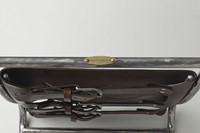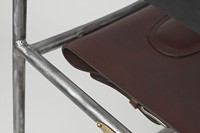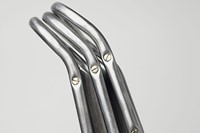A quirky short illustrates Ally Capellino's latest design creation, reinventing tubular chairs with her trademark exquisite leatherwork
“I like the simplicity and functionality of the tubular steel chairs. They've really stood the test of time, design-wise if not production-wise. They are having a new lease of life amongst buyers of second-hand furniture. I like that they are basic and universal in use. They are utilitarian which appeals to me, and then the way we treated it had a resonance with the metal work we use on our bags. We use contrasting metal, contrasting leather colours such as the black with the brown. All quite basic simple things but things that we use in what we do. The chairs have been stripped back to the raw steel. The leather is a vegetable tan leather, which polishes nicely under a bum.”
"The leather is a vegetable tan leather, which polishes nicely under a bum” — Ally Capellino
Ally Capellino’s Bums on Seats reinvents a set of tubular metal stacking chairs, examining the way that we look and position ourselves on seats. Produced with photographer Donald Christie and designer Rupert Blanchard, the traditional plywood of the chair has been replaced using embossed leather that reflects various seating positions, with playful titles such as Knees Up and The Lean. The tubular stacking chair of the 1950s stands as a milestone within British design. Popular for their durability and affordable price, they now represent a period of post-war working Britain. They were inspired by Thonet’s Bauhaus steel designs, who is also famed for his Bentwood café chairs.
Together, Christie, Blanchard and Ally have produced a short film to accompany the series of Capellino chairs, which pulls on Bauhaus inspiration stimulated by a 1957 short film, A Chairy Tale by Norman McLaren.
Ally Capellino's collection Bums on Seats are on show from today as part of the Best of Britannia exhibition in Clerkenwell.
Text by Mhairi Graham


